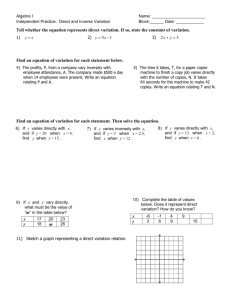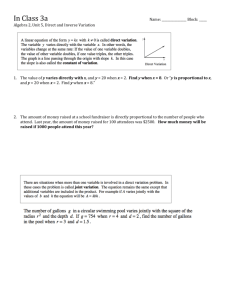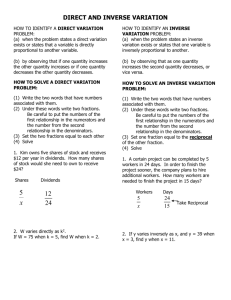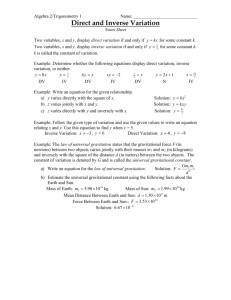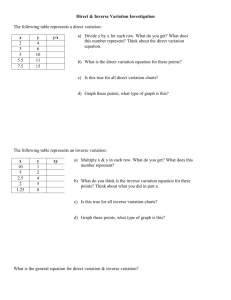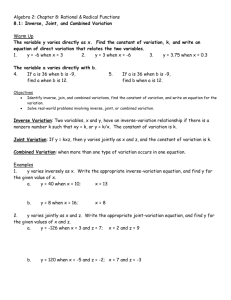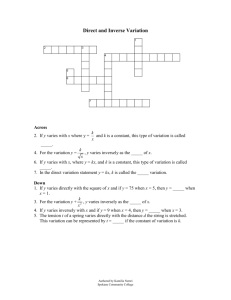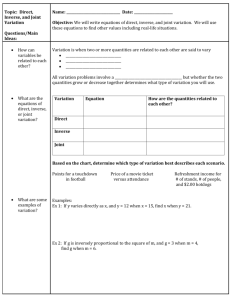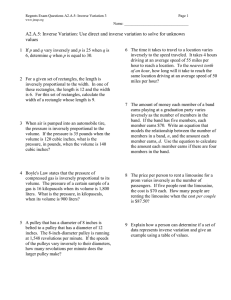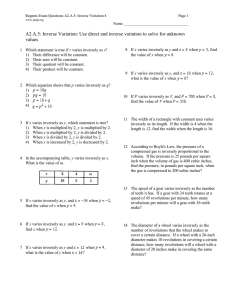Direct and Inverse Variation Worksheet
advertisement
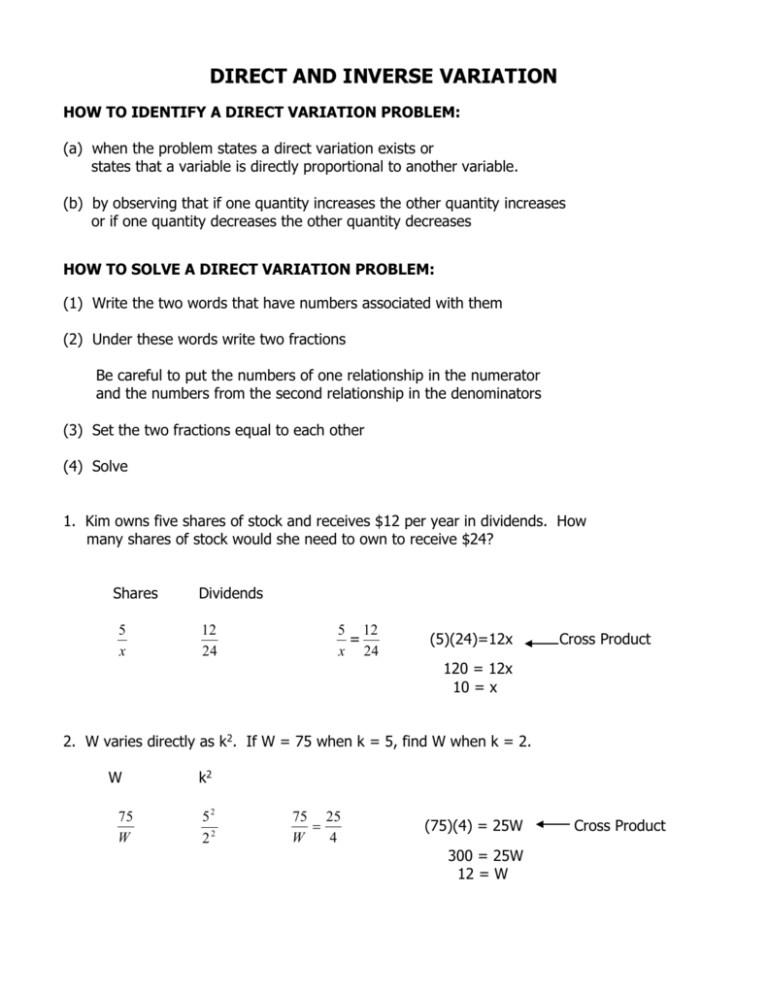
DIRECT AND INVERSE VARIATION HOW TO IDENTIFY A DIRECT VARIATION PROBLEM: (a) when the problem states a direct variation exists or states that a variable is directly proportional to another variable. (b) by observing that if one quantity increases the other quantity increases or if one quantity decreases the other quantity decreases HOW TO SOLVE A DIRECT VARIATION PROBLEM: (1) Write the two words that have numbers associated with them (2) Under these words write two fractions Be careful to put the numbers of one relationship in the numerator and the numbers from the second relationship in the denominators (3) Set the two fractions equal to each other (4) Solve 1. Kim owns five shares of stock and receives $12 per year in dividends. How many shares of stock would she need to own to receive $24? Shares 5 x Dividends 12 24 5 12 = x 24 (5)(24)=12x Cross Product 120 = 12x 10 = x 2. W varies directly as k2. If W = 75 when k = 5, find W when k = 2. W 75 W k2 52 22 75 25 W 4 (75)(4) = 25W 300 = 25W 12 = W Cross Product HOW TO IDENTIFY AN INVERSE VARIATION PROBLEM (a) when the problem states an inverse variation exists or states that one variable is inversely proportional to another (b) by observing that as one quantity increases the second quantity decreases, or vice versa HOW TO SOLVE AN INVERSE VARIATION PROBLEM (1) Write the two words that have numbers associated with them (2) Under these words write two fractions Be careful to put the terms of one relationship in the numerators and the terms of the second relationship in the denominators (3) Set one fraction equal to the reciprocal of the other fraction. (4) Solve 1. A certain project can be completed by 5 workers in 24 days. In order to finish the project sooner, the company plans to hire additional workers. How many workers are needed to finish the project in 15 days? Workers 5 x Days 24 Take Reciprocal 15 5 15 x 24 (5)(24)=15x Cross Product 120 = 15x 8=x 2. If y varies inversely as x, and y = 39 when x = 3, find y when x = 11. y 39 y x 3 11 Take Reciprocal 39 11 y 3 39(3) = 11y 117 = 11y 117 y 11 Cross Product 1. Three-fourths of an ounce of a medication are required for a 120 lb adult. At the same rate, how many ounces of medication are required for a 200 lb adult? 2. If a train travels between two cities in 3 hours at an average speed of 65 miles per hour, how long would it take at an average speed of 80 miles per hour? 3. Neglecting air resistance, the distance d that an object falls varies directly as the square of the time t it has been falling. If an object falls 64 feet in 2 seconds, determine the distance it will fall in 6 seconds. 4. x varies inversely as y3. x is 16 when y is 5. Find x when y is 2. (To do these, compare “cross products.” The answer that produces the same cross product as the equation that you wrote is the correct choice.) 5. A 20-acre field produces 300 bushels of wheat. Let W represent the number of bushels produced by a 50-acre field at the same rate. Select the correct statement of the given condition. A. 20 = 300 C. 20 = 300 50 W W 50 B. 20 = W 50 300 D. 20 = 50 W 300 Ans: A 6. W varies inversely as the square of t. If W = 12 when t = 2, find t when W = 27. A. 27t = 24 B. 27t2 = 48 C. 108 = 12t2 D. 12t = 54 Ans: B 7. The pressure P of a compressed gas is inversely proportional to the volume V. If there is a pressure of 25 pounds per square inch when the volume of gas is 400 cubic inches, find the pressure when the gas is compressed to 200 cubic inches. A. 200P = 10000 B. 25P = 80000 C. 400P = 5000 D. none of the above Ans: A 8. An experimental drug is given to 100 people with a certain ailment. Fifty-three of these people were cured by the drug. Select the statement of condition for the expectation of a cure C if 2000 people with the ailment are given the drug. A. C = 53 100 2000 C. C = 2000 53 100 B. 10 = 53 D. 100 = 53 Homework: pages 464: 7, 8, 11, 12, 21, 23, 25 C 200 C 2000 Ans: C Ans: 8) 6 amps 12) 40 lb.
